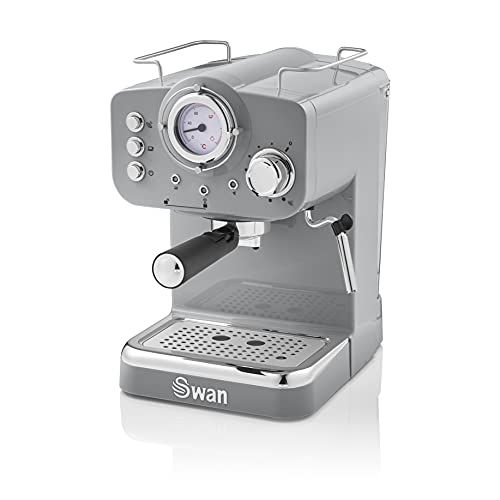How to Make Espresso Machine Coffee
An espresso machine can make a delicious cup of coffee, but it needs some extra setup and maintenance than a typical drip coffee maker. It also requires that you grind and grind your own beans.
Pressure is the most important factor in making espresso. Here's how an espresso maker operates: a heating device prepares water to the right temperature, then it pushes it through the grounds before pouring out the spouts.
Temperature
Espresso is created by forcing hot water under pressure through finely ground coffee beans. The temperature of water is vital to the final shot. Low temperatures lead to less extraction of essential flavor compounds. High temperatures can cause over extraction and can cause burnt or bitter tastes.
The ideal temperature for espresso is between 195 and 205degF. This temperature can be achieved using a grouphead designed to ensure an unchanging temperature and stability throughout the brewing process. The E61 is the most popular group head as it offers temperature stability, pre-infusion capabilities, and lever control.
It is essential to take into account the temperature when you adjust your espresso machine for different roasts or brew ratios. This can impact the extraction yield as well as the crema. The ideal temperature will differ depending on the roast and bean. However the general rule is that lighter roasts with higher brew rate require higher temperatures. A reliable thermocouple is vital to maintain the temperature at a constant level.
Pressure
In the process of brewing, espresso machine coffee is pressure-pushed through finely ground and tamped coffee grounds. This triggers chemical reactions that extract flavors oils, flavors, and other soluble components from the beans. The beverage that is made is usually richer and more flavorful.
The ideal espresso machine pressure is nine bars of pressure which is the same as atmospheric pressure at sea level. This is due to the fact that it is at this pressure that the espresso bean's soluble compounds are the easiest to extract.
However certain espresso machines advertise 15 or even 20 bars of pressure. These machines might be able to reach these pressure levels, however, they might not be able to maintain them throughout the extraction.
To put it into perspective To put it in perspective, one bar of pressure equals 32 pounds per square inch PSI of the tire of a car. It's more than four-times the pressure a professional cyclist applies to their bicycle tires. coffeee.uk to control the espresso machine's pressure, and to make consistent espressos is key for any serious barista at home.
Water
Water is an essential component to a perfect cup of espresso. The right water allows your beans reach their full potential. However the wrong type of water could cause problems like clogging pipes or even damage to your expensive machine.
The best option is natural spring water that is high in minerals for optimal espresso extraction. This water will enhance the flavor of your coffee without the chalky mineral trace that comes from tap or bottled waters. This is an excellent alternative to distillation or reverse osmosis filtered water, which can be too pure and can cause issues with flavor.
It is not recommended to use a water filtration system that removes excessive mineral content from the water you drink. This could cause taste and extraction issues. Get a water test kit to determine the average hardness of your local water. This information can be used to find the ideal filtration system for your espresso machine.
Beans
Most coffee lovers tend to be very involved in the process of making espresso. They are obsessed with a variety of variables, including temperature, water pressure beans, milk, viscosity and other factors. If one of the variables is slightly off, the whole shot could taste bad.
The beans used are the most important thing when it comes to espresso. Many people believe that only certain types of beans work well for espresso. While certain beans are than others for specific purposes but any bean that is roasted can be used to make espresso. The main difference between espresso beans and regular coffee beans is that espresso beans are roasted more by tipycally extending past the second crack that gives them an appearance darker and makes them more soluble in water.
Dark or medium roasted beans are the best for espresso as they impart the espresso with richness and boldness. Light roasted beans can also be used to make fantastic espresso, especially when they're pre-ground to make it easier to use an espresso maker.
Milk
Espresso and milk are a traditional combination. The coffee doesn't just boost energy levels, but the steamed milk helps to offset the bitterness of the espresso and provides a delicious creaminess. There aren't many culinary combinations more perfect than this one!
When choosing an espresso machine capable of making latte, or a cappuccino it is important to consider how easy it will be to use. Many of the best machines come with a jug that can be used for hot or cold coffee and steam wand. They also come with a portafilter to pull the shot. Some models also have an integrated grinder as well as a tamper and a frother.

To get rid of any condensed water the steam wand should be purged each day before use (or after every cup of espresso). This process takes about 30 seconds and is important to ensure that your machine is operating smoothly. If you don't flush, it can cause a bitter taste and/or a accumulation of bacteria that could alter the flavor or aroma of your beverage. It's not difficult to do and should be a part of your routine maintenance.
